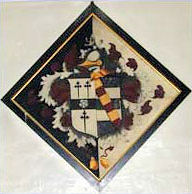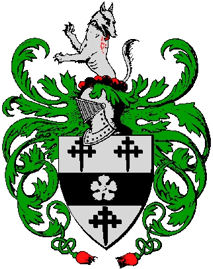|
Church Lawton, Cheshire, (close
to Stoke-on-Trent)
Background to the Church Lawton area
William the Conqueror's Domesday Survey refers to the area
as "Lautune" and says that it belonged to Hugo de Mara, one of the
kings fellow Normans. The whole of the County of Cheshire had been
given over to the King's brother in law, Hugh Lupus (Hugh the Wolf),
a character notorious for his riotous living who, on his deathbed,
vowed to establish a church at Lawton, "If the Lord would only spare
him."
The church lands were passed over to the Abbot of St. Werburgh's
at Chester, a place of worship was erected and the Abbot appointed
one Edward as the first Rector of Lawton in the year 1180. The
architectural remain of this earliest church is the Norman Arch
doorway over the south door.
Between 1180 and the 15th century the village
of Lawton was in two halves, one half being the church lands, or the
"Glebe" on which is now built the Lawton Gate Estate, and the
remainder which was owned by the squire of Lawton. The legend of the
Lawton family dates back to around the year 1200 when King John was
separated from his companions while hunting in the area. The story
is that his horse reared and threw him when it was confronted by a
great wolf, whereupon a nearby keeper came to the rescue and killed
the wolf.
The man gave his name as keeper Adam de Lauton and,
for saving his life, the King granted him all the land he could walk
over in a week, taking the bleeding wolf as his starting point. The
King told him, "The head of the wolf shall be thy crest; thy deed
will go down in history."
|
 The
Lawton Family can thus trace their family tree to the time of
this exploit, and their family crest is to be found several
times in and around the parish church. The
Lawton Family can thus trace their family tree to the time of
this exploit, and their family crest is to be found several
times in and around the parish church.
The Lawton Coat of Arms, which is linked with
the Davenport family, consists of the three crosses of Calvary
and the Tudor Rose underneath a wolf licking it's left
shoulder. The motto "Spes Infrecta" means "Hope Unbroken".

Arms -
"Argent, on a fesse between three crosses crosslet fitche
sable, as many cinquefoils of the field."
Crest - "A
demi wolf salient regardant argent, vulned in the breast
gules."
|
In the C17 the inhabitants of Lawton were
mainly employed in agricultural pursuits and there is also mention
of some salt mining at one time in the parish. The woodlands which
also encouraged the opening of an iron making furnace.
A John Turner of Stafford obtained a 21-year
lease in the year 1658 for the conversion of a corn-mill into a
furnace; this must have been a substantial enterprise as he invested
£3000 in the making of the furnace and forge. Subsequent records
show that the iron making business was the later leased to the Foley
family who were great iron-masters in the 17th century. During the
period 1696 to 1704 the annual output of pig-iron rose from 700 tons
to 900 tons, and up to 30 men would have been employed in the heyday
of this former Lawton industry.
The next development which had a
great effect upon Lawton was the construction of the Trent and
Mersey Canal which was completed in 1777. This was one of the many
such engineered by the famous James Brindley, and this 93-mile
waterway formed part of the busy network of horse-drawn water
transport. The feature of the length through Church Lawton is the
number of locks known as the Red Bull Flight and the Lawton Flight.
The church registers provide evidence of the
many who were employed as Overseers, Lock-keepers and Boatmen, and
the carrying of coal, salt and minerals used in the nearby pottery
industry kept the canal very busy until the coming of the steam
railway. Now, after years of being virtually unused, the canal is
again busy as a popular section on the waterways holiday route. Many
Lawton men were employed as colliers in the many coal mines in the
area, and at one time there was a coal-pit at the Red Bull end of
the parish.

|
 
next:
the
turnpike road
previous:
Church Lawton |
![]()
![]()